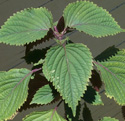
Every spring I plant a number of Vietnamese herbs in my home garden. Purple and green leaf tia to (red perilla) and lemongrass-y kinh gioi (Vietnamese balm) are my favorites. I feed and nurture my perennial rau ram (Vietnamese coriander) so that it will flourish when the summer heat hits.
Tia to and kinh gioi often get buggy when I plant them together so over the years I've learned to space them far apart. Tia to goes into a whiskey barrel and kinh gioi is planted in the ground outside my front door. Every morning, I look at the kinh gioi plant to make sure that it's doing well. This morning, I had a feeling that our local gopher was going to attack the plant. Last year, the gopher ate the plant and I thought it was because it had been mistaken for a volunteer potato plant nearby, which the gopher ate too. I cleared the area this year of the potato but low and behold, there was a scrawny plant that popped up. "What is that thing next to the kinh gioi?" my hubby, Rory, asked yesterday. I saw the potato plant but didn't yank it. This afternoon, Rory awoke from his nap and something looked different outside the living room window. That darn gopher ate both the potato and kinh gioi! The lesson here? Yank the potato and/or plant the herb in a pot! All that's left now is some roughed up soil -- as the photo on the left shows. ARGGHH.
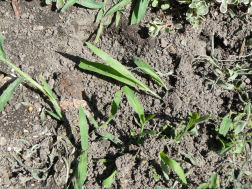
Guess I'll be heading back to the Thien Thanh grocery store in San Jose for another plant. If you're looking for Viet herbs to plant, head to a Vietnamese market and ask. You may even find vendors selling starters right outside the door!
Gardening Tips
To keep pests away from my Vietnamese herbs, I sprinkle Sluggo -- small white pellets made of natural stuff that won't harm your pets but will keep pesky snails at bay. For bugs that like to gnaw on the heady leaves, I regularly spray the plants with Safer, a safe (get the name?!) insecticidal soap. To nurture the plants, I feed them with Dr. Earth, a fabulous dry fertilizer. Of course, regular watering helps all of these plants.
Harvesting Vietnamese herbs
Pinch them back to get the plants nice and bushy. When harvesting, snip a good sprig so that the plant will bush out instead of get tall and leggy -- which won't yield many leaves. As the plants begin to flower, snip off the flowers to encourage the plants to put energy towards producing leaves, not flowers.
Save Seeds
At the end of the season in fall, let the plants flower and go to seed. Collect the seeds and save them or sprinkle them into the soil for next year's crop.
Seed and Plant Sources
I usually go to a Viet market in San Jose called Thien Thanh (455 Keyes Street) and they sell starter plants by the front entrance. If you live near a Viet enclave check the markets in the late spring for plants. If you want to go mail order, try these sources:
- Ever Green Seeds specializes in Asian veggies. Their pepper seed selection makes you weep for joy.
- Since 1917, Kitazawa Seed Company in Oakland, CA, has specialized in Asian vegetable and herb seeds. Among many things, they carry seeds for hojiso -- a Japanese perilla similar to tia to.
- Richter's Herbs from Canada is awesome, but can be slow with delivery. Request a catalog or order online to get things like thorny cilantro (ngo gai) and Vietnamese balm (kinh gioi).
- Baker Heirloom Seeds from Missouri has seeds from all over the world, including Southeast Asia.
- Flora Exotica in Canada lists a wealth of Vietnamese and Asian herbs on their site and will send worldwide, they claim.
More Information
For details on Vietnamese herbs (e.g., botanical names, descriptions, photos, and storage tips) visit the Vietnamese Herb Primer page!













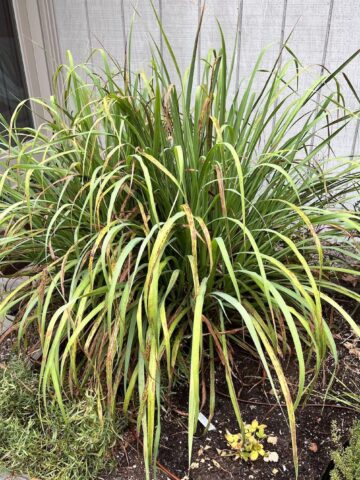
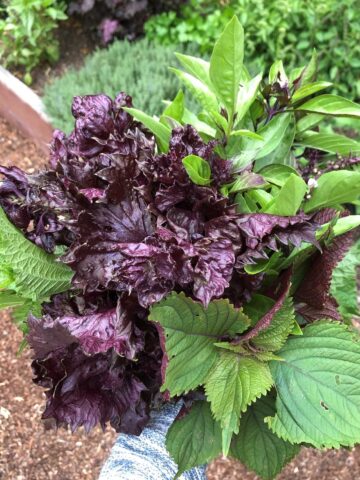
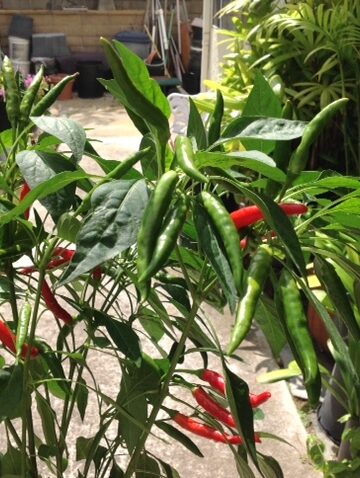

Rosa says
I'd love to grow my own herbs, but firstly, I have to find the seeds I'm looking for...
Andrea Nguyen says
Rosa, I just added a link to the post (see the end of the post) so that you may learn more about Vietnamese herbs, including where to find seeds. Thanks!
Simon Bao says
When starter plants aren't available at Viet markets, or when starting plants from seeds seems problematic, many of the herb plants can be grown as cuttings. If the plants are sold as "stems & leaves," and not just as leaves, one can usually get them to root using the same techniques used for any other plants. There are instructions for how to do this all over the web (http://www.rainyside.com/archives/cuttings.html ) and all one needs to do is purchase the very freshest, liveliest looking her
Andrea Nguyen says
Definitely, fresh cuttings are the fastest way to generate new herb plants. Watch out for fish mint, which spreads like the dickens and you can't get rid of it!
Simon Bao says
Andrea, here's a random, drive-by question with a bizarre premise...
Can any of the Viet herbs be dried and if so, do they retain any type of flavor that makes it worth the effort?
Most are not "culinary herbs" in the sense that sage or thyme or rosemary are for Euro cuisines. They're more like "salad herbs" and are always used fresh. I cannot think of any good reason why anyone in Vietnam should ever bother to dry some Tia To or Rau Ram or other herbs - sounds implausible. But I was telling
Andrea Nguyen says
Simon, I've not known any Viet person to dry herbs. If they were to use it for medicinal purposes, they'd just steep the leaves in hot water for a fresh herbal infusion. Eating the herbs straight is highly therapeutic. My dad has a friend who swears that fish mint (vap ca) is great for hemorrhoids.
But for culinary uses like what you're specifically asking about, I think not. The seeds and flowers, once dried, have great fragrance and I can see using them sort of like how chefs have been using f
Simon Bao says
Andrea, I think there is something that you and I might both want to try sometime. And that is dried purple Tia To/purple perilla. I was also *mostly* sure that there's no use for the herbs as dried herbs, but it seems that in Japanese cuisine there is. For dried Tia To, at least. I googled the phrase "dried shiso" and found many references to and descriptions of dried purple shiso (Tia To) being used both as flakes and as some form of powder, and also dried shiso leaves being used as a flav
Andrea Nguyen says
Simon, I always let the plants dry up at the end of the season so I effectively have dried tia to. The flowers and buds have nice flavor but I've never tried the dried leaves.
Yes, Kitasawa's hojiso is a close relative of our tia to but the flavor is a bit milder. Japanese friends of mine taste tia to and say, that's not shiso. Funny you should ask about this because I had an email exchange with Bill Daley of the Chicago Tribune's Food Section about the year-round availability of tia to. He was
Glenyce says
I am in Ho Chi Minh City, Vietnam, at the moment and no-one here seems to be able to tell me where I can buy seeds for herbs. Does anyone know? Glenyce
Andrea Nguyen says
Glenyce, I have no idea for HCMC. If it's for your personal garden, you can take some of the fresh herbs and root them in water. Just put them in a glass of water and they'll grow roots. When you think there's enough to establish the plant, stick it in some soil! This works with rau ram, kinh gioi, ngo om, and lemongrass.
beachanytime says
Glenyce, I have had a lot of luck getting rau ram and rau thom plants(vietnamese coriander and spearmint) just from rooting the stems from the herbs I get from the market. This is probably a lot faster than seeds. I usually choose the ones that have the heavier stems (fat and woody). With both, remove and use the leaves at the bottom of the stems, but leaves a few at the top of the stems. Then just put the stems in a glass of water, with just enough water to cover the bottom part (about 2 cm). I
Robert Carlyle says
I don't use a lot of vietnamese vegetables. How much will a single plant product? And can it be put in the freezer for future use?
Robert ("Bobby") from How To Build Greenhouse
merryb says
How big, please, are the leaves of rau ram?
I have a plant named "vietnamese coriander", which has kinda of segmented stems, rau ram-shaped leaves about one inch long at longest, and no maroon colored spots. It likes evenly moist soil, NO drying breezes from central ac/heat, and very shady conditions. It creeps in its pot rather than growing from a central stem. Currently, it is only about 8" high at its highest.
If it is not rau ram, does anyone have a guess what this plant could be?
Thank y
Laura says
Your article is interesting... I grow herbs, but never, ever thought of growing Vietnamese herbs... even though I love Pho! I think I'll give them a try this summer.
urinary tract infection supplements says
Thanks for the wonderful tips. Sometimes it's hard to find these herbs that's why it helps to grow your own.
hemorrhoid says
Can you grow these in Canada or will they die?
pharmacy says
But for culinary uses like what you're specifically asking about, I think not. The seeds and flowers, once dried roots appear, and you can plant the stems in good, humid soil. I find that at this stage the soil should not be too wet, or the newly rooted stems may rot. Good luck!
Abbi John says
I really enjoy simply reading all of your weblogs. Simply wanted to inform you that you have people like me who appreciate your work. Definitely a great post. Hats off to you! The information that you have provided is very helpful.
buy xanax online
Nickle says
wow! this will help a lot to my body, I can't wait to try this one.
marlon says
Simply wanted to inform you that you have people like me who appreciate your work.
Bonnie says
Hi, I love your site, I’ve learned so much from you. I have a question, can I grow tia to by putting a stalk in water like mint or foes need to grow from seeds. Thank you
Andrea Nguyen says
It should work if the tia to is fresh and the weather warmish. A lot of Vietnamese people do that to root and propagate new herb starters!